Sunday – Leominster – Bright sunshine and a blue sky. The River Lugg is flowing clear but shallowly. A row of expensive cars are lined up for auction, a Rolls Royce, Bentley, Lotus and others. The grass is wet with dew. The market is fairly big. For once I see something that would be useful, a vernier gauge, but it is being held by someone else, who purchases it! Into Paradise Walk where a Great Tit is calling strongly. A Mallard glides down the Kenwater. By the time I arrive home it is beginning to cloud over. We drive to Surrey for Kay’s mother’s 99th birthday. The sky is dark with cloud but it does not rain and they break up by mid-afternoon. All the great grandchildren are there having a fine time as Great Grandma looks on.
Monday – Woking – Yesterday’s clouds have gone leaving a clear blue sky. The early morning had an autumnal nip to the air, after all is the meteorological autumn now. Down the main road in West End that runs from Reading to Woking. Side of the road there are Oak trees probably less than 20 years old and carrying a reasonable acorn crop. Other Oaks are older maybe 50 or 60 years at least. Nearby are Blackthorns but they have no sloes at all. A Holly has no berries either. In the distance comes the sound of gunfire from the famous Bisley rifle range.
I leave the bus in the centre of Woking. Across the road are the modern buildings of the New Victoria Theatre and the Civic Centre. Behind tower blocks are being constructed. A bridge crosses the Basingstoke canal. At one end of the bridge is a bronze statue of Sir Alex Bedser, the Surrey and England cricketer by sculptor Allan Sly. At the other end of the bridge is another bronze, Eric Bedser, also a Surrey cricketer. Beyond the bridge is a large building occupied by the World Wildlife Fund. Beyond is Brewery Road, which once ran to Horsell Brewery. It is very difficult to compare the old maps of Woking with the modern town – much has changed unrecognisably. Woking is mentioned as the site of a monastery in the 8th century, Wochingas. In the Domesday Book it appears as Wochinges, being held in 1086 by the King, Walter FitzOther, Constable of Windsor Castle, and Ansgot and Godfrey from Osbern FitzOsbern, then bishop of Exeter. The town was not more than a scattering of cottages until the Basingstoke Canal opened in 1794. It grew slightly around the railway station, built in 1838 at the junction between the lines to London, the south 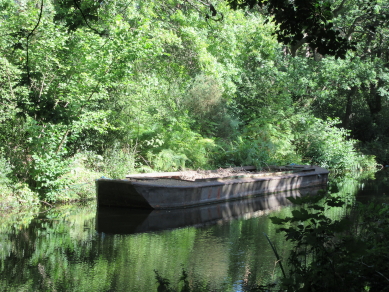 coast, and the south-west of England. It expanded in the second half of the 19th century but was still a relatively small town. However, much of the town was redeveloped in the late 20th century and continues to grow now.
coast, and the south-west of England. It expanded in the second half of the 19th century but was still a relatively small town. However, much of the town was redeveloped in the late 20th century and continues to grow now.
I take the steps down to the canal tow-path. At Chobham Road Bridge, formerly The Wheatsheaf Bridge, named after a pub further up the road, it is necessary to climb steps and cross the road before descending again to rejoin the tow-path. The canal is lined by from fine trees behind which are early 20th century houses. Nuthatches call from above. Clumps of bamboo grow all along far side of the canal. The buildings on this side of the canal are modern. Now there is a park beside the canal. Opposite is it old motorless barge. It has as worn sign stating “Surrey and Hampshire Canal Society”, who were key players in the restoration of the Basingstoke Canal.
The peaceful setting of the canal is somewhat spoilt by the constant noise of traffic and, possibly even worse, the roaring drone of aircraft lifting out of Heathrow airport. A Jay screeches in the trees. Carrion Crows and a Magpie joins in, then the cause of all the noise sweeps through, a Common Buzzard pursued by the corvids. The woods on the far side are south western corner of Horsell Common. The tow-path now passes Boundary Road recreation ground with its cricket nets, skateboard ramps and children’s playground, but not a single child. The houses on the opposite side of the road date from the 1890s.
Three Mallard drakes are on the canal. They are beginning to emerge from eclipse and get their breeding colours back. Chocolate Bullrush heads and mauve Water Mint grow up through Brambles on the edge of the canal. A pair of Moorhen stand on the far side in the shallow water surveying surroundings. More Mallard dabble. A black and blue striped dragonfly, a Southern Hawker, Aeshna cyanaea hovers moves on then hovers again. Past a winding bay, an inlet in the canal where boats can turn around. This side of the canal now is lined with industrial units and loud engines. A pair of mating dragonflies are being chased by a third. The pink flowers of Great Willowherb are turning into fluffy seed. An old winding mechanism, part of a crane, by Tangyes of Birmingham stands on a plinth next 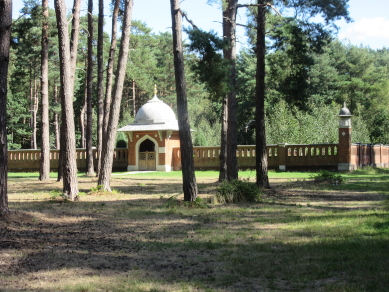 to Monument Road Bridge.
to Monument Road Bridge.
Up onto the bridge. The bridges across the canal all have features which make them look older than they are, the beds are all concrete. The other side of this bridge is a large area of demolished building which is flooded. It was called Britannia Wharf. There was a wharf here leading off of the canal with a works next to it. At some time it was a packaging factory and in the 1990s an office block was constructed here. That has been demolished and plans have been submitted for residential use. Just behind the wharf is a Bronze Age barrow. A short distance north is an enclosure which was built in 1915 as a Muslim burial ground for Indian soldiers who lost their lives in the Great War. The graves have now been removed to Brookwood cemetery. Site was designed by architect TH Winney and completed in 1917 by Ashby and Horner Ltd. The Chattri near Patcham in Brighton was erected for Sikh and Hindu soldiers and this was a dedicated Muslim cemetery built on a site owned by the Earl of Onslow. Inside the walls of the cemetery now is a garden with a water feature, a rectangular pond been fed by a stream which flows down from the monument of remembrance.
Across the road and onto an area of Heather and Birch on Horsell Common. The place is famous as the setting for H G Wells’ “War of the Worlds”. The name possibly comes from the Anglo-Saxon horig scylf, meaning “muddy slope”. A large tumulus stands in the centre of this open space. There are a number of bronze age barrows on Horsell Common. These are bell and disc barrows which are very unusual for this area. This sort of barrow is far more common in Wessex and it may have been travellers from that area who constructed these. In the trees on the far side of this space is a Green Woodpecker. Through the woods of Oak, Birch and Pine. Blue and Great Tits chatter. The path emerges from the woods at Six Cross-roads.
Along the Chertsey road to Anthonys, a small hamlet. Houses date from late Victorian through to modern. There is a pub on the main road. The hamlet consists of the houses along the road and then more set back. There is a chapel here but has been converted into a residence and without the name plaque with not be recognisable as such. The house is also called Chapel Cottage on the main road.
A path leads through the woods. A ridge which runs parallel to the path through the woods is probably the base of an old wall or boundary hedge. This idea is reinforced when some way into the wood a modern fence has been erected on the ridge. Danewell House is hidden beyond. Now behind the fence is Woodham church hall. The path emerges onto the Woodham Lane. A short distance along the road is All 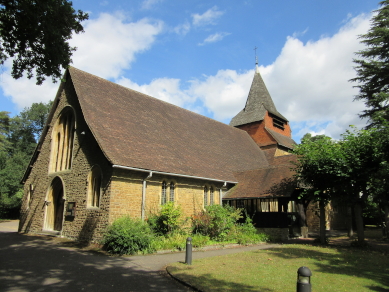 Saints church. A war memorial stands in front of the church. It was designed by Inigo Triggs and dedicated on 10th July 1920. The church is known as the “Little Church at Six Cross-roads. It was built in 1893 by W F Unsworth in Old Surrey style in dressed rubble stone, with a square tower with broach spire above the crossing. There are paired lancet windows, a timber gabled south porch with a mock Norman south door. The glass is early 20th century, some recent replacements following vandalism. A panel over the altar is believed to be 10th century from a church in Rome. From there it was moved to the church of St Restituta in Casa Iccicolaon the island of Ischia. The town and church were destroyed in an earthquake on 28th July 1883. The panel was excavated in 1895 almost undamaged and installed here in 1905.
Saints church. A war memorial stands in front of the church. It was designed by Inigo Triggs and dedicated on 10th July 1920. The church is known as the “Little Church at Six Cross-roads. It was built in 1893 by W F Unsworth in Old Surrey style in dressed rubble stone, with a square tower with broach spire above the crossing. There are paired lancet windows, a timber gabled south porch with a mock Norman south door. The glass is early 20th century, some recent replacements following vandalism. A panel over the altar is believed to be 10th century from a church in Rome. From there it was moved to the church of St Restituta in Casa Iccicolaon the island of Ischia. The town and church were destroyed in an earthquake on 28th July 1883. The panel was excavated in 1895 almost undamaged and installed here in 1905.
The woodland path continues on the other side of the road. Just off the path is a very large Wood Ant nest several feet high. There are more nests scattered through the woods. A single nest can contain up to quarter of a million ants, so there clearly millions of ants in this wood. The path is running parallel to Monument Road. A Green woodpecker yaffles. The park passes the Muslim cemetery and then take the road over the canal into Maybury. Houses are early 20th century, Guildford Terrace is dated 1902. One house has been horribly modernised with tall gates with eagles on it, cladding and a veranda and fountains in mock Italianate style.
The road passes under the main London railway line then rises up Maybury Hill. I now turn into Oriental Road. A retail park is on one side of the road on the site of the Oriental University Institute, before that the Royal Dramatic College stood here. On the other side is St Paul’s church, built in the late 19th century. Above an aircraft is climbing and flying in and out of clouds. The road continues past modern office blocks and late 20th century apartments and housing. The bright green dome of the Shah Jahan Mosque peers over a corrugated iron roof. This was the first purpose-built mosque in the UK, commissioned by Shahjehan, Begum of Bhopal (1868-1901), one of the four female Muslim rulers of Bhopal who reigned between 1819 and 1926. A development of older people’s residential homes has been built on the site of The London and South Western Railway Servants’ Orphanage which was founded Jeffreys Road, Clapham, in 1885. The Revd Canon Allen Edwards, who was Vicar of All Saints Church, Lambeth and the Railway Chaplain of Nine Elms, opened a home for fatherless girls, the first child being admitted in 1886. A few years later he acquired the building next door and started admitting fatherless boys. All these children had lost their fathers who had been employed by the London and South Western Railway. In 1909, this site, Woking Grange, was opened. An extension was added in the 1930’s which at that time could house two hundred children all of whom were children of railway families. The home was financed by “the rank and file railwaymen” who contributed one old penny per week out of their wages. The name of the home was changed in 1923 to the Southern Railway Servants’ Orphanage. In 1947 the Board of Management opened a home for retired railwaymen across the road from the main Woking Grange site. It was then 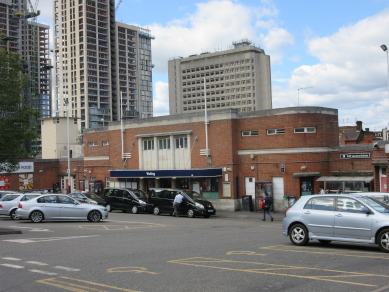 called the Southern Railwaymen’s Home for Children in association with the Southern Railway Home for Old People. Kay recalls some of the girls attending her secondary school. They were identifiable by their “sensible” shoes! She also recalls there were good Christmas parties at the home. In the early 1970’s the Children’s Hospital (Grace Groom House) was refurbished to house the older people and in 1981 an extension was built to accommodate 14 retired railway workers. In 1982 the name changed to Woking Homes. By 1989, all the children had left and the site was redeveloped and continues to be a charity whose objects are the relief of those who have at any time been employed in any capacity within the rail industry.
called the Southern Railwaymen’s Home for Children in association with the Southern Railway Home for Old People. Kay recalls some of the girls attending her secondary school. They were identifiable by their “sensible” shoes! She also recalls there were good Christmas parties at the home. In the early 1970’s the Children’s Hospital (Grace Groom House) was refurbished to house the older people and in 1981 an extension was built to accommodate 14 retired railway workers. In 1982 the name changed to Woking Homes. By 1989, all the children had left and the site was redeveloped and continues to be a charity whose objects are the relief of those who have at any time been employed in any capacity within the rail industry.
The transition from leafy suburb the town centre is sudden. The Post Office sorting office of 1935 stands on the edge of the town centre opposite is a similar period parade of shops and apartments. Set back is Woking railway station, built in the 1930s in the Art Deco style, probably by Southern Railway’s chief architect James Robb Scott. A subway goes to the town centre. It has a tiled fresco depicting railway engines. Victorian and Edwardian buildings stand amongst modern glass constructions. A bank is dated 1908. A larger than life statue of a man, “The Wanderer” is part of an art trail advertising an exhibition of the work of Sean Henry, an internationally renowned sculptor who was born in the town in 1965. Church Path is lined with multinational restaurants and estate agents. House prices are pretty much what one would expect in this part of the country.
I stop for a rest and a pint. It is clouding over now. The old streets here are confused by modern building and pedestrianisation. Commercial Way has a long parade of shops including Commercial Buildings are early 20th century, some possibly older buildings and a lot of 1950s and 60s shops of very little architectural interest. In the pedestrian precinct is an area with the war memorial in the centre surrounded by an arc of glass fronted modern buildings housing chain stores. Christ church stands one corner of this square. It was built in 1889 by W.F. Unsworth. There is a large bookshop and cafè but the church is a barn-like area with a few scattered chairs and no atmosphere at all. Across the road is the Town Gate, designed by Alan Dawson depicting the history of Woking – a Scots Pine, brick-making, canal, railway, H G Wells and the Borough Crest. It was opened in 1992 and I will confess I see little of the concept in the gate. There is another Sean Henry statue nearby. Round to Chapel Street. Commercial House is tatty. Further up there is a hockey museum. Unsurprisingly it is only open two days a week and not today. Up to what is euphemistically called High Street. Here is the back entrance and wall of Woking station, actually because the town centre has moved to this side of the railway, this is the most used entrance. Here, a range of old-fashioned shops – the Home and Colonial, green grocer, Victoria wine, milliners etc is just a façade, literally a painted wall. It is from here I catch the bus back to West End. Route
Wednesday – Bodenham Lake – Along the track from the car park. A Dunnock is sunning itself on the edge of the hedge. A Chiffchaff calls. A small deer walks quietly but quickly across the path, possibly a Muntjac. There is bright sunshine and a blue sky and this is reflected in the wind rippled water of the lake. A Green Woodpecker yaffles in the distance. The numbers of Coot on the lake is increasing. A Cormorant is on the water, beak lifted into the air in a snooty pose. Two others fly away. A small group of Canada Geese are gabbling on the far side. The Mute Swan family are on one of the new islands at the west end. A Great Crested Grebe glides on its own in the middle of the water. Here also on open water is a Moorhen seemingly unsure which way to go. Water level is low, a lot of the scrape is exposed. The flowers in front of the hide, mainly Black Knapweed and St Johns Wort have all turned to seed. Hips are ripening. A few Mallard are at the western end. A twittering charm of Goldfinches flies past. Back along the edge of the Alder plantation, the blackberries are shrivelled and brown, their season already over. A linesman trudges up the pasture after inspecting the electricity pylon. Damselflies flit around the grasses in the meadow. Apples are ripening in both orchards, I pick up some windfalls.
Friday – Hereford – The temperature has dropped and the autumnal feeling increases. The sky is grey, dark clouds almost motionless. A brisk wind stirs the trees. Two bus drivers chat at the bus station – in Polish, Europeans working hard, contributing to society, unlike some of our old Etonian politicians.
Off the bus at Holmer. The church is locked. There is a very large base to the churchyard cross. The cross and shaft are a 19th century replacement but the base is 14th century. The graveyard is fairly large what is now a small suburb of Hereford. Beyond an extensive is being cleared and new housing is being erected. A large house stands next to the church, the former vicarage. It has been extended considerably and is now a nursing home. Along Church Way. Considerable ground-works are being undertaken at Copelands, a large 19th century house with a 17th century core, on the corner of Coldwells Road. On past the rear of Holmer Park. The area was once farms and large Victorian houses. It is now subsumed into extensive modern developments which architecturally are as boring as they possibly could be. A footpath continues eastwards. A mulberry tree is dropping black fruit. The path emerges from the housing estates. Across the road are what were two large ponds, both appeared with dried out now. On and on through more and more late 20th century developments until I reach the Roman Road.
Into Old School Lane. The area was known as Holmer Within. The road passes a sports ground on one side and a large industrial site on the other. Yarrow flowers on the roadside bank. There are just a few houses but they seem to cover pretty much every decade of the 20th century. Over the railway line, yet to divide into the Manchester and Worcester routes and into College Hill estate, an interwar housing estate which is bounded by the line. There are hundreds of former council houses here, sold off at discount prices on tax cuts for the rich and leading to the present housing crisis. The estate ends at the junction of College Road and Barrs Court Road. Barrs Court was a large farmhouse to the east of this junction. By the 1920s it had been replaced by Jeffrey’s tile works and St Barnabas’ Mission Church. The church had gone by the early 1970s, the tile works by the end of the century. The road crosses the railway line again, here it is four tracks. Sidings show little sign of usage, many others have already been removed, particularly on the eastern side of the tracks where the engine shed stood. Over and down Burcott Road. Over the old canal and on towards the city centre.
At the end of Newtown Road, Widemarsh Brook passes underneath the road. A small bridge crosses the heavily choked stream. Into Widemarsh Street. A large pub built in 1939 is now on an interior decoration shop. I rest a few moments in the rose garden in the old Blackfriars Priory behind Coningsby hospital. Opposite the former high school failed as an academy is now going to be part of the new university of Hereford. In Hightown, scaffolding around the building, Booth Hall, that caught fire some ten years ago is finally coming down. A rack of brand new hire bikes stand outside St Peter’s church. A new artisan bakers has opened in St Owens Street. Route
Sunday – Leominster – Ephemeral vapour trails criss-cross the near cloudless sky. The Priory bell calls the faithful. From the railway bridge an inversion layer over the River Arrow can be seen as a thin layer of cloud. There is a vague mistiness over the wet fields of the Lammas meadows. The water level in the Lugg remains low, the water is still crystal clear. Bundles of pale brown keys hanging from the branches of an Ash. Easters meadow has been mown. Across the river Long-tailed Tits, 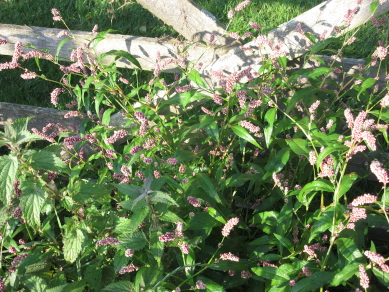 Blackbirds, Starlings and unidentified small brown birds dance around a dying tree. A Robin sings in a Black Poplar. Branches bounce under the minimal weight of foraging Blue Tits. Bistort still has its pink flowers. Winged fruits hang on Sycamore branches close to the ground. The green leaves with red stalks suggest a young tree. Skeletal remains of tall umbellifers and rust-red Dock stand above dying grasses and Stinging Nettles. Fresh molehills have been thrown up beside the path.
Blackbirds, Starlings and unidentified small brown birds dance around a dying tree. A Robin sings in a Black Poplar. Branches bounce under the minimal weight of foraging Blue Tits. Bistort still has its pink flowers. Winged fruits hang on Sycamore branches close to the ground. The green leaves with red stalks suggest a young tree. Skeletal remains of tall umbellifers and rust-red Dock stand above dying grasses and Stinging Nettles. Fresh molehills have been thrown up beside the path.
The market is still sizeable despite the drop in temperature. The first Christmas items have already appeared. There are still a good number of Water Boatmen on the Lugg just beyond Ridgemoor Bridge. A Chiffchaff sings a broken version of its song alongside the railway. The Kenwater remains shallow and clear.
Home – Weeding is needed again; Groundsel and Couch Grass is spreading rapidly. The purple-sprouting broccoli is staked. Some lettuce seedlings are planted out. I put rings cut from plastic bottles and yoghourt pots around them in an attempt to keep slugs away. A large container of tomatoes is harvested from the greenhouse. A cucumber is growing well. The sweet peppers are disappointing. Courgettes are doing well and there are a couple of squashes developing. A couple of days ago the apricot tree in the fruit cage was cut down. It has not produced any flowers or fruit for many years, just a lot of branches and foliage that push their way through the netting. This morning I cut up the cuttings and put them in a large bulk bag to take to the compost bin at the waste disposal site. Kay is sorting out the rose bower. It is not a happy area, one rose seems largely dead, another is all over the place but at least alive and largely without disease. I remove a couple of branches from a nearby tree that are growing over the bower. This allows better air circulation and more light. A wire frame is placed over the pond in an attempt to limit the amount of leaves that get into the water this autumn.
A decent number of Blue, Great and Coal Tits visit the seed and peanut feeders. Rustling can be heard from the flower beds where Blackbirds are scratching through leaves for food. The hens are still laying well. A Chiffchaff calls intermittently. A scattering of leaves near the wall suggests a Wood Pigeon has met its demise, probably by a Sparrowhawk.
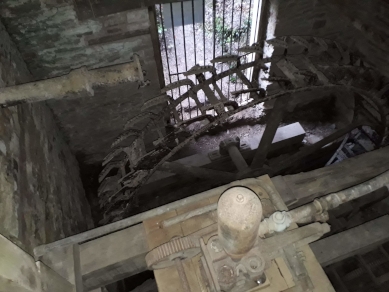
Monday – Croft – It has been raining since the early hours. Mist hangs thinly over the trees and obscures Bircher Common. A large flock of sheep are in the field beside the long drive to Croft Castle. All but a very few have their backs to the west from whence comes the rain. A new rustic gate stands across the path at the top of Fishpool Valley; apparently sheep have been reintroduced to the valley or at least parts of it as there is new fencing running down the hillside. The old Pumping House has been extensively restored. A new wooden door allows entrance to the building with a platform overlooking the great water wheel and later pump. The great timbers of the first pump, a beam pump are still in place. Contractors are working on the dam by the limekiln. They are also renovating the next dam up the valley, where a large spillway has been constructed. Over the valley, seats have been installed in the grotto. Up out of the valley. More conifers have been cleared on the far side of the forestry track.
On the path towards Lienthall Common. The only sound is the noise, technically pink noise, of rain drops and the rustling leaves in the wind. Not a single sound from any bird. Up onto Croft Ambrey Iron Age hill-fort. Cloud lays across the top of the hill forming a wall of white in every direction. A Larch is growing through one of the old Ashes creating a strange combination of leaves. There  are still a few Harebells in flower along the edge of the path The Brambles are loaded with ripe blackberries, strange nobody has collected any. Onto the Mortimer Trail on the west side of the hill-fort. A Blue Tit cheeps and a Nuthatch whoops.
On down the tracks towards the Castle. A toadstool rises out of the grass by the track. There are at least half a dozen possible contenders for identification in the field-guide and as I have commented before, life is too short to keep searching for the name. However, nearby is a dead Oak log with small black fungi growing on it, one I can name, Black Witches Butter, Exidia glandulosa. Rain has eased slightly. From the Spanish Chestnut field, Herefordshire lays under glowing grey clouds, all is misty and the distant hills vanished. The Spanish Chestnuts are covered with spiky fruit. Even the saplings planted just a few years ago have nuts upon them. Wood Pigeons perch up on the Chestnuts’ dead stag horn branches. A brown-black slug slides across the path. A Robin sings from the Oak trees overlooking the pond which is green with algae. A Great Spotted Woodpecker chips from another Oak. Another calls from the top of a conifer in Park House garden.
are still a few Harebells in flower along the edge of the path The Brambles are loaded with ripe blackberries, strange nobody has collected any. Onto the Mortimer Trail on the west side of the hill-fort. A Blue Tit cheeps and a Nuthatch whoops.
On down the tracks towards the Castle. A toadstool rises out of the grass by the track. There are at least half a dozen possible contenders for identification in the field-guide and as I have commented before, life is too short to keep searching for the name. However, nearby is a dead Oak log with small black fungi growing on it, one I can name, Black Witches Butter, Exidia glandulosa. Rain has eased slightly. From the Spanish Chestnut field, Herefordshire lays under glowing grey clouds, all is misty and the distant hills vanished. The Spanish Chestnuts are covered with spiky fruit. Even the saplings planted just a few years ago have nuts upon them. Wood Pigeons perch up on the Chestnuts’ dead stag horn branches. A brown-black slug slides across the path. A Robin sings from the Oak trees overlooking the pond which is green with algae. A Great Spotted Woodpecker chips from another Oak. Another calls from the top of a conifer in Park House garden.
Wednesday – Leominster – The tail end of hurricane Dorian blows through. The sky is grey and threatening rain. Down to the White Lion and along the public footpath past the new Pinsley Mill development. Into the Millennium Park. Cider apples are beginning to fall. The crop is very mixed this 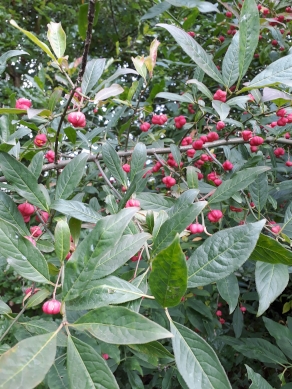 year, a number of trees are barren. The area is also covered in Stinging Nettles so collecting the fruit is not going to be easy. The church bells ring. Delicate pink fruits have appear appeared on the Spindle trees. Purple Loosestrife flowers in what was a pond. The last of the Meadow Cranesbills are still blooming. Suddenly the sun appears along with patches of blue sky. Bunches of elderberries hang from the branches, some already rotting. Into the churchyard. A fat Wood Pigeon stands on the church sign, moulting feathers sticking out untidily.
year, a number of trees are barren. The area is also covered in Stinging Nettles so collecting the fruit is not going to be easy. The church bells ring. Delicate pink fruits have appear appeared on the Spindle trees. Purple Loosestrife flowers in what was a pond. The last of the Meadow Cranesbills are still blooming. Suddenly the sun appears along with patches of blue sky. Bunches of elderberries hang from the branches, some already rotting. Into the churchyard. A fat Wood Pigeon stands on the church sign, moulting feathers sticking out untidily.
I then head for the small local hospital where a physiotherapist examines my problem ankle. As usual, I have the hospital placebo effect, it has improved over the past few days! She gives me some exercises and another appointment is arranged. She wants to do some more tests in a week which will hopefully confirm her diagnosis, which she does not want to reveal until she is sure, but she is sure that it will improve.
Home – I gather a fair number of Worcester Pearmain apples. There are a lot of small ones because I failed to thin them sufficiently. There are also a lot with bird damage and mould. Yesterday I picked what plums there were. They too have suffered from mould and bird attack. Neither the Cox’s or Hereford Russet apples are ready yet. I pull a few radishes. Courgettes are coming thick and fast, a large bag were frozen yesterday.
Thursday – Croft – Another grey morning. I started early gathering cider apples and now my back is extremely painful due to the bending – how fed up I am with getting old! Down into the Fishpool Valley. Rooks caw in the distance. A Robin sings strongly. Down in the valley there are more Robins in every direction, all trying to establish their territories. Across the dam by the pump house and up into the Beech wood. Wood pigeons coo loudly. The new sheep fence crosses the  hillside. A Nuthatch calls overhead. A path crosses the hillside. New seats have been placed at various spots along the valley side overlooking the valley. Cloud is thickening and it is getting darker. The path passes in front of the refurbished grotto. There is a small alcove on the northern side of the grotto (it faces west) with a window in it.
hillside. A Nuthatch calls overhead. A path crosses the hillside. New seats have been placed at various spots along the valley side overlooking the valley. Cloud is thickening and it is getting darker. The path passes in front of the refurbished grotto. There is a small alcove on the northern side of the grotto (it faces west) with a window in it.
The path comes to a gate and then joins the ride that crosses the hillside. Up the forestry path and start gathering blackberries – they are everywhere. I can afford to be very choosy, no stretching, if one does not want to come off leave it, if too small leave it – there are plenty more. I keep gathering as I come up onto the hill-fort. A pristine Red Admiral butterfly flutters past. Several House Martins fly over the top of the hill. Views are extensive today right out to the hazy Black Mountains, Sugarloaf peeps over the southern hills, the Malverns are blue line across the horizon. People have been harvesting the blackberries but there are so many that it is not apparent until one gets up close to the Brambles. A wind blows across the hillside, getting stronger and it is looking stormy. This is the remnants of tropical storm Gabrielle. I have filled my containers and head back down to the castle.
Sunday – Leominster – The sky is almost completely covered in cloud. The morning temperature is quite low now around 10°C or 11°C. The River Lugg water level is also low. A farmer somewhere has done some muck spreading, the rich aroma fills the air. A Grey Heron flaps over high in the sky. Ravens bark over the field at the foot of Eaton Hill. The market is getting smaller but is still busy. My back has not improved and it is a slow, painful walk home.
Wednesday – Leominster – It is a vaguely misty morning and the coolest so far, as low as 5°C. Across the Grange. The three-pronged lobes of Beech mast are folded back exposing the nuts.
Home – Long-tailed Tits pass through the garden. Bees and hover-flies are visiting the Golden Rod in the garden. The Bramley apple crop is much reduced on previous years. Some are gathered and gently stewed with a few cloves, to be frozen for the winter. A fair number of tomatoes in the greenhouse are getting soft and splitting. They are picked and mixed in olive oil with onion, garlic, a bit of aubergine that was lurking in the fridge, courgette and thyme and then into the oven. The mixture is then liquefied a bit and frozen. Some small, hard figs are picked. A large crop of climbing beans are now being left to dry for winter stews. Much rustling comes from all directions as Blackbirds kick up the leaf litter.
Monday – Home – It is the autumn equinox. We have had a few bursts of heavy rain during the last couple of nights, which has been welcomed by the garden. Spiders are weaving webs all over the place. One is just outside the bathroom window and another between the edge of the window and next door’s extension. The top thread of this web is probably two yards long. Both webs have spiders dealing with their victims, they look like small flies. Another web is by the front door. They are all Garden or White Cross Spiders Araneus diadematus, the white cross on their backs stand out against the brown and black patterns.
Cross Spiders Araneus diadematus, the white cross on their backs stand out against the brown and black patterns.
The Millennium Park apple orchard has been strimmed and apples are falling. This is incredibly frustrating, my back problem means I have not been able to process the last batch I collected i.e. the ones that actually caused the back injury! It will not be long before it will be too late to make any cider this year which is very disappointing. Meadow Cranesbill and Purple Loosestrife are still in flower, but coming to the end of their season. The breeze strengthening, thickening clouds drift across the sky. The specimen trees in the Peace Garden are all fruiting – Black Mulberry, Paper-bark Birch and Hornbeam. Across Pinsley Mead. In the garden behind the wall of a house at the end of Pinsley Mead is a pear tree with a fine crop of large pears – I am jealous.
Home – One of the hens, Russet I assume, has laid the tiniest egg in the run. It is smaller than a Blackbird egg! The courgettes are still coming fast. Tomatoes and beginning to come to the end now. There still are some beans but they are too high to pick without the ladder, so they can be left to provide dry beans along with many others lower down. The lettuces I had planted out have all been eaten despite all the precautions I took. Some beetroot have grown to a reasonable size and can be cropped soon. The chard remains disappointing. I have gathered in most of the Worcester Pearmain apples and put a couple of trays in store. The Herefordshire Russets are still not ready.
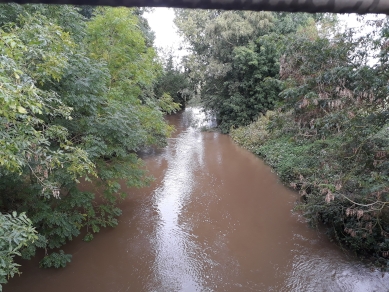
Monday – Leominster – A quick visit to the River Lugg. There has been heavy rain over the past week and many places have experienced flooding. Yesterday the Worcester Road, close to where I am standing now by the White Lion, was under water. It is hardly surprising that the Lugg is running high and very coloured.
Home – A couple of rows of garlic are planted out. Brambles are coming over the west wall through the Ivy that clambers all over a pear tree. I use the extendible loppers to cut it off. The chicken run is very muddy and consequently so are the eggs. Heavy rain returns in the early afternoon.